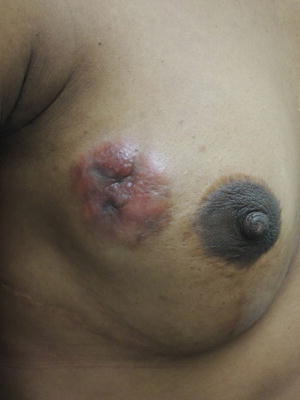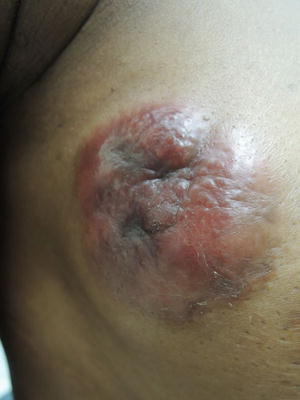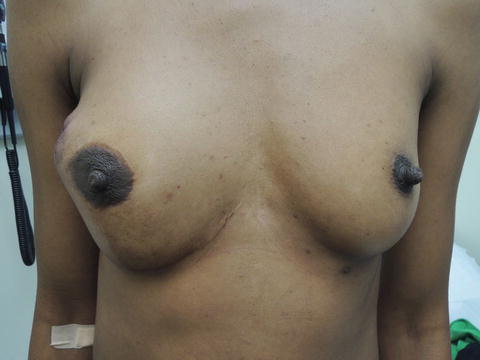, Corinna Eleni Psomadakis2 and Bobby Buka3
(1)
Department of Family Medicine, Mount Sinai School of Medicine Attending Mount Sinai Doctors/Beth Israel Medical Group-Williamsburg, Brooklyn, NY, USA
(2)
School of Medicine Imperial College London, London, UK
(3)
Department of Dermatology, Mount Sinai School of Medicine, New York, NY, USA
Keywords
Breast cancerBreastMalignancyPuckeringDimplingErythemaInflammationSkin changesUlcerInfiltrationDischargeDistortionPruritusCancerBreast cancerPeau d’orangeNipple inversion
Fig. 22.1
Indurated, fixed, non-tender mamillated plaque at right outer breast

Fig. 22.2
Rapid growth over months is a concerning feature of any lesion

Fig. 22.3
Tissue retraction prominent at right breast
Primary Care Visit Report
A 37-year-old female with past medical history of Vitamin D deficiency presented for an annual physical exam. She was concerned about a lump in her right breast that she had first noticed about 2 months prior. She noted that the skin overlying the lump had become discolored over the past 2 months, it was sometimes tender, and the lump had been growing in size. She had no family history of breast cancer. At age 16, she had a benign breast lump in the same breast. The lump was removed at that time and an implant was placed in her right breast. The implant was then removed 2 years later, at age 18. Her last mammogram 2 years prior was normal.
Vitals were normal. On exam, around 10:00 of her lateral right breast, there was a 7 cm × 7 cm indurated area, with a central 5 cm × 3 cm area of discoloration. The lesion was purple-colored and erythematous, with central puckering .
The breast mass and associated skin changes were highly suggestive of breast cancer. The patient was referred to a breast surgeon the following day for biopsy. The mass was found to be cancerous, and the patient eventually underwent chemotherapy, a right modified radical mastectomy, and radiation therapy.
Discussion from Dermatology Clinic
Differential Dx
Intraductal papillary carcinoma
Metastatic carcinoma
Paget’s disease
Favored Dx
The changes in size and texture of the breast point to an internal malignancy , and the skin changes seen most likely represent local invasion of the skin by breast cancer.
Overview
Skin changes are associated with a number of internal malignancies, which can manifest in a variety of ways. These include local invasion of the skin by an adjacent cancer, metastasis to the skin from a distal cancer, and changes that are suggestive of various familial cancer syndromes. The skin changes seen in this case represent local invasion by an underlying breast cancer.

Full access? Get Clinical Tree








